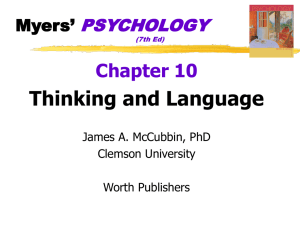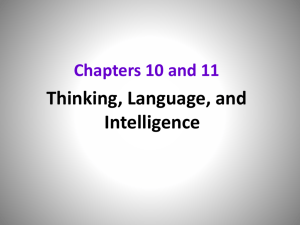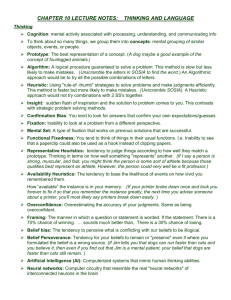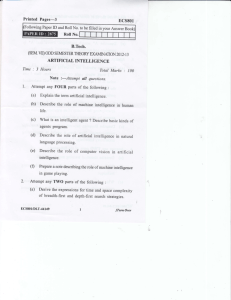ch_10 powerpoint (thinking and language).
advertisement
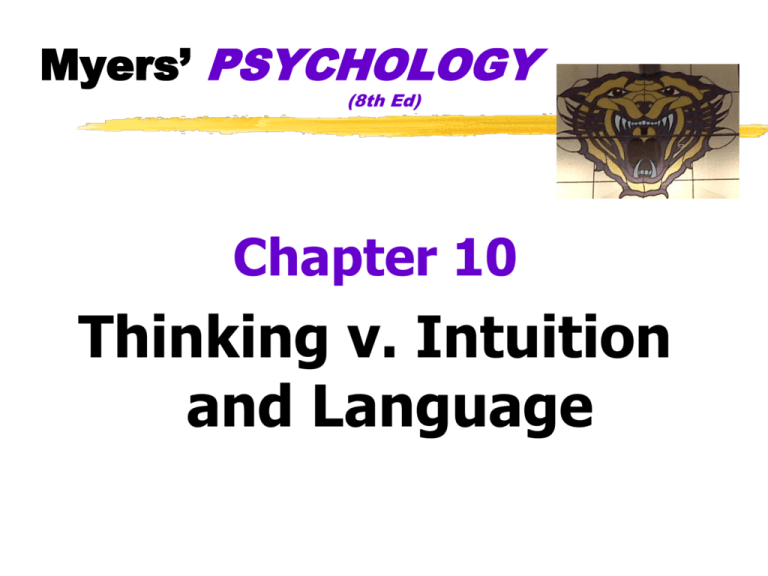
Myers’ PSYCHOLOGY (8th Ed) Chapter 10 Thinking v. Intuition and Language “ A bat and ball cost$1.10. The bat costs $1 more than the ball. How much does the ball cost?” “A man bought a horse for $60 and sold it for $70. Then he bought the same horse back for $80 and again sold it for $90. How much money did he make in the horse business?” 10, 4, 3, 11, 15, …? 100204180 YYURYYUBICURYY4ME Question: “All members of the cabinet are thieves.” No composer is a member of the cabinet. What logical conclusion can you draw? Answer Some thieves are not composers or said another way, there are thieves who are not composers… Tower of Hanoi In only 7 moves, move the tower from the left peg to the right peg, moving only 1 disk at a time and never putting a larger disk on a smaller one… Good Luck! Thinking Cognition mental activity associated with processing, understanding, and communicating information Cognitive Psychology the study of these mental activities concept formation problem solving decision making judgement formation study of both logical and illogical thinking Thinking Concept mental grouping of similar objects, events, or people Hierarchies example- the address • country, state, city, zip code, street, house or apt. # Prototype the best example of a category matching new items to the prototype provides a quick and easy method for including items in a category (as when comparing feathered creatures to a prototypical bird, such as a robin.) Thinking Algorithm methodical, logical rule or procedure that guarantees solving a particular problem contrasts with the usually speedier – but also more error-prone use of heuristics Thinking Heuristic rule-of-thumb strategy that often allows us to make judgements and solve problems efficiently usually speedier than algorithms more error-prone than algorithms sometimes we’re unaware of using heuristics Thinking Unscramble SPLOYOCHYG Algorithm all 907,208 combinations Heuristic throw out all YY combinations other heuristics? Thinking Your brother has suffered from chronic depression for several years. Unfortunately, you have been incorrectly informed by your parents that there is a 40% chance you will also suffer from depression. How can your thinking lead you to believe they’re right? Remember, TDA! Thinking Insight sudden and often novel realization of the solution to a problem contrasts with strategy-based solutions OBSTACLES TO PROBLEM SOLVING: Confirmation Bias tendency to search for information that confirms one’s preconceptions Fixation inability to see a problem from a new perspective impediment to problem solving Thinking- Insight Wolfgang Kohler’s experiment on insight by a chimpanzee The Matchstick Problem How would you arrange six matches to form four equilateral triangles? The Matchstick Problem Solution to the matchstick problem The Three-Jugs Problem Using jugs A, B, and C with the capacities shown, how would you measure out the volumes indicated? The Three-Jugs Problem Given jugs of these sizes: Problem C Measure out this much water: A B 1 21 127 3 100 2 14 46 5 22 3 18 43 10 5 4 7 42 6 23 5 20 57 4 29 6 23 49 3 20 7 15 39 3 18 The Three-Jugs Problem Solution: a) All seven problems can be solved by the equation shown in (a): B-A-2C= desired volume. b) But simpler solutions exist for problems 6 and 7, such as A-C for problem 6. Thinking Mental Set tendency to approach a problem in a particular way especially a way that has been successful in the past but may or may not be helpful in solving a new problem Thinking Functional Fixedness tendency to think of things only in terms of their usual functions impediment to problem solving The Candle-Mounting Problem Using these materials, how would you mount the candle on a bulletin board? The Candle-Mounting Problem Solving this problem requires recognizing that a box need not always serve as a container Heuristics Representativeness Heuristic rule of thumb for judging the likelihood of things in terms of how well they seem to represent, or match, particular prototypes may lead one to ignore other relevant information Heuristics Availability Heuristic estimating the likelihood of events based on their availability in memory if instances come readily to mind (perhaps because of their vividness), we presume such events are common Example: airplane crash Thinking Overconfidence tendency to be more confident than correct tendency to overestimate the accuracy of one’s beliefs and judgements Thinking Framing the way an issue is posed how an issue is framed can significantly affect decisions and judgements Example: What is the best way to market ground beef- As 25% fat or 75% lean? Thinking Belief Bias the tendency for one’s preexisting beliefs to distort logical reasoning sometimes by making invalid conclusions seem valid, or valid conclusions seem invalid Belief Perseverance clinging to one’s initial conceptions after the basis on which they were formed has been discredited Artificial Intelligence Artificial Intelligence designing and programming computer systems to do intelligent things to simulate human thought processes • intuitive reasoning • learning • understanding language Artificial Intelligence Artificial Intelligence includes practical applications chess playing industrial robots expert systems efforts to model human thinking inspired by our current understanding of how the brain works Artificial Intelligence Computer Neural Networks computer circuits that mimic the brain’s interconnected neural cells performing tasks learning to recognize visual patterns learning to recognize smells Language, “The jewel in the crown of cognition.” Language our spoken, written, or gestured works and the way we combine them to communicate meaning Phoneme- Building block 1 in a spoken language, the smallest distinctive sound unit, bat- b,a,t Language Morpheme- Building block 2 in a language, the smallest unit that carries meaning may be a word or a part of a word (such as a prefix) Grammar- Building block 3 a system of rules in a language that enables us to communicate with and understand others Language Semantics the set of rules by which we derive meaning from morphemes, words, and sentences in a given language, ed= past also, the study of meaning Syntax the rules for combining words into grammatically sensible sentences in a given language, adjective before noun- white house Language We are all born to recognize speech sounds from all the world’s languages Percentage able 100 to discriminate 90 Hindi t’s 80 70 60 50 40 30 20 10 0 Hindispeaking adults 6-8 months 8-10 months 10-12 months Infants from English-speaking homes Englishspeaking adults Language Babbling Stage beginning at 3 to 4 months the stage of speech development in which the infant spontaneously utters various sounds at first unrelated to the household language One-Word Stage from about age 1 to 2 the stage in speech development during which a child speaks mostly in single words Language Two-Word Stage beginning about age 2 the stage in speech development during which a child speaks mostly two-word statements Telegraphic Speech early speech stage in which the child speaks like a telegram – “go car” – using mostly nouns and verbs and omitting “auxiliary” words Language Summary of Language Development Month (approximate) Stage 4 Babbles many speech sounds. 10 Babbling reveals households language. 12 One-word stage. 24 Two-word, telegraphic speech. 24+ Language develops rapidly into Complete sentences. Language Genes design the mechanisms for a language, and experience fills them as it modifies the brain Language Environment spoken language heard provides input to Genes Brain design Mechanisms for understanding and producing language Behavior Mastery of native language Language Percentage correct on grammar test New language learning gets harder with age 100 90 80 70 60 50 Native 3-7 8-10 11-15 17-39 Age at school Language Linguistic Determinism/ Relativity Whorf”s hypothesis that language determines the way we think Language Direction of nectar source The straight-line part of the dance points in the direction of a nectar source, relative to the sun •Describe the nature of concepts and the role of prototypes in concept formation. •Discuss how we use trial and error, algorithms, heuristics, and insight to solve problems. •Describe how the confirmation bias and fixation can interfere with effective problem solving. •Explain how the representative and availability heuristics influence our judgments. •Describe the effects that overconfidence and framing can have on our judgments and decisions. •Discuss how our beliefs distort logical reasoning, and describe the belief perseverance phenomenon. •Describe artificial intelligence, and contrast the human mind and the computer as information processors. •Describe the effects that overconfidence and framing can have on our judgments and decisions. •Discuss how our beliefs distort logical reasoning, and describe the belief perseverance phenomenon. •Describe artificial intelligence, and contrast the human mind and the computer as information processors. •Describe the structure of language in terms of sound in terms of sounds, meanings, and grammar. •Trace the course of language acquisition from the babbling stage through the two-word stage. •Explain how the nature-nurture debate is illustrated in theories of language development. •Discuss Whorf’s linguistic relativity hypothesis and the relationship between thought and language. •Describe the research on animal cognition and communication, and discuss the controversy over whether animals can use language.
